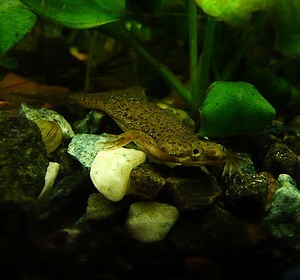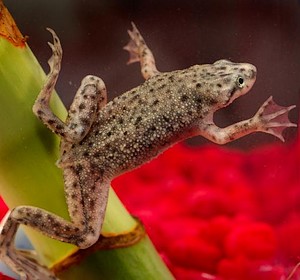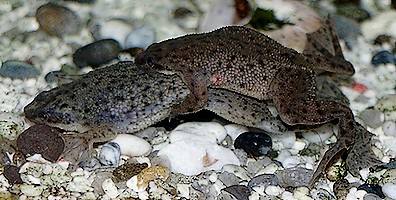
| Species | African Dwarf Frog |
|---|---|
| Latin name | Hymenochirus boettgeri |
| Family | Pipidae |
| Occurrence | Africa |
| Length | 4 cm |
| Temperature | 24-26 [°C] |
| pH | 6.0-8.0 |
| Water hardness | soft to medium hard |
| Tank | 25 [L] |
In natural conditions, this frog inhabits constant or slow flowing waters of lowland rain forests in the equatorial zone of Central Africa (Nigeria, Cameroon, Gabon, Equatorial Guinea). It is a very common aquatic species in these regions. It should not be confused with the clawed frog, which grows up to several centimeters in length.
This amphibian is characterized by its gray-brown body coloration, with darker spots and a light belly. The skin is covered with small bumps. Its head is conical, eyes are round and flat, without eyelids. It also lacks a tongue. Hind legs are long and end in claws. Their structure does not allow the dwarf to move on dry land, which does not mean that it does not sometimes come out of the water. The fingers of the hind and front legs are connected by swim membranes. These frogs breathe atmospheric air (they have lungs), but are typically aquatic animals. The skin of this species undergoes strong keratinization, resulting in its shedding in flakes (a natural phenomenon). Females are slightly larger and bulkier in the belly areas. The male emits sounds during the breeding season and also has a subcutaneous gland in the groin, which bulges during periods of sexual activity on the skin surface in form of a white-pink thickening.
It is an active, curious species that can be kept with fish or shrimp. However, we should remember, that eggs, fry and young shrimp will constitute a variety in their diet. Fish that we would like to match with the dwarf should not be predators, they should also not be larger than frogs. We avoid fish referred as "algae-eaters" or possessing a mouth opening shaped like a sucker (they recognize a frog as a stone they can scrape food from); we also avoid long-finned fish - they will be tormented by amphibians. This species of frogs quickly adapts to new conditions - it is quite resilient and resistant. It also has the ability to regenerate lost limbs.
that eggs, fry and young shrimp will constitute a variety in their diet. Fish that we would like to match with the dwarf should not be predators, they should also not be larger than frogs. We avoid fish referred as "algae-eaters" or possessing a mouth opening shaped like a sucker (they recognize a frog as a stone they can scrape food from); we also avoid long-finned fish - they will be tormented by amphibians. This species of frogs quickly adapts to new conditions - it is quite resilient and resistant. It also has the ability to regenerate lost limbs.
When preparing an aquarium for our frogs, we need to consider primarily the tank bottom surface - the larger, the better. However, the level of water should not exceed the height of 25-30 cm, as they will have a difficult path to the surface to get air. The equipment of the tank should include a filter (with a secure outlet and free flow) and a heater (properly secured against a possible burn of the delicate frog skin). Lighting is not required, and if applied, it should be diffused. Additionally, in the aquarium we provide a large amount of hiding places (roots, plants, etc.), a tight tank cover. It is a good solution to use floating plants with wide leaves, but it is necessary to leave free spaces on the water surface. The substrate and decorative elements used should not have sharp edges. The water should be clean and mature, replaced regularly once a week (around 25%).
These frogs are characterized by interesting behaviour during the breeding season. They reach sexual maturity approximately a year after hatching. Then the male selects a territory at the bottom of the tank, usually in a secluded, shaded place (of area up to 4 dm²). He starts to sing / croak at night. He assumes a characteristic position - with his hind legs straight, as if he were supporting himself on the front ones. The series of sounds is interrupted, the male changes his position slightly, turning his head in another direction. And so for several hours. He only interrupts singing to get air or during feeding. The whole singing is aimed at tempting a female to the selected territory. However, it often happens that within the designated territory another male or completely another animal appears. When our male hears the song of another male, he promptly tries to locate him, and then to ward him off (you can then observe two frogs trying to push each other around using their muzzles and front legs). But when an animal appears within the territory that does not make any sound, the male promptly performs the mating clasp (so-called axillary amplexus). It is an unconditional reflex, therefore it can be performed on any moving object - regardless of whether it will be an animal or an object. If it happens to be a male dwarf (not singing) or an immature female, they indicate the error to our male by appropriate movements of their hind legs and pelvis, and the clasp is released within a few to several minutes. The moment he encounters a fertile female, he loses interest in his own territory, gaining food or even drawing air. The clasp is not released until all eggs are lain, and the male passively attached to the female submits to her fate for the next few hours. The female does not lay eggs immediately, however egg laying always proceeds according to a certain scheme. The female swims up to the water mirror (with the male on her back), draws air, then turns upside down (in such a way that her anus and the male's anus protrudes slightly above the water surface), lays a part of eggs, which the male fertilizes at the same moment (usually up to 10 pieces), turns back around and goes to the bottom to rest (several minutes). The whole process takes about 30-40 seconds, takes place in silence and is repeated many times until the female lays all the eggs (about 50 climbs). A completed work is signaled by the female to the male by stretching her hind legs. The male releases the clasp. The eggs are about 1.2 mm in size and hatch within 1-2 days. In the initial period of life, the larvae stay on the surface of the water. Only after 3-4 days from hatching they start to swim actively in search of food. Parents should be removed as they are cannibals. The youngsters are very sensitive to water quality (almost daily water changes are necessary) and grow very fast. After about 1-2 months, metamorphosis occurs into fully functional, but small frogs.
It is an unconditional reflex, therefore it can be performed on any moving object - regardless of whether it will be an animal or an object. If it happens to be a male dwarf (not singing) or an immature female, they indicate the error to our male by appropriate movements of their hind legs and pelvis, and the clasp is released within a few to several minutes. The moment he encounters a fertile female, he loses interest in his own territory, gaining food or even drawing air. The clasp is not released until all eggs are lain, and the male passively attached to the female submits to her fate for the next few hours. The female does not lay eggs immediately, however egg laying always proceeds according to a certain scheme. The female swims up to the water mirror (with the male on her back), draws air, then turns upside down (in such a way that her anus and the male's anus protrudes slightly above the water surface), lays a part of eggs, which the male fertilizes at the same moment (usually up to 10 pieces), turns back around and goes to the bottom to rest (several minutes). The whole process takes about 30-40 seconds, takes place in silence and is repeated many times until the female lays all the eggs (about 50 climbs). A completed work is signaled by the female to the male by stretching her hind legs. The male releases the clasp. The eggs are about 1.2 mm in size and hatch within 1-2 days. In the initial period of life, the larvae stay on the surface of the water. Only after 3-4 days from hatching they start to swim actively in search of food. Parents should be removed as they are cannibals. The youngsters are very sensitive to water quality (almost daily water changes are necessary) and grow very fast. After about 1-2 months, metamorphosis occurs into fully functional, but small frogs.
They are predators - both tadpoles and adult frogs. Carnivorous. Their diet should consist of live or frozen food. They cheerfully eat: daphnia, mosquito larvae, tubifex worms, earthworms, fry, shrimp (pieces), pieces of freshwater fish. The food should be varied. Young frogs are fed daily, older ones every 2-3 days.